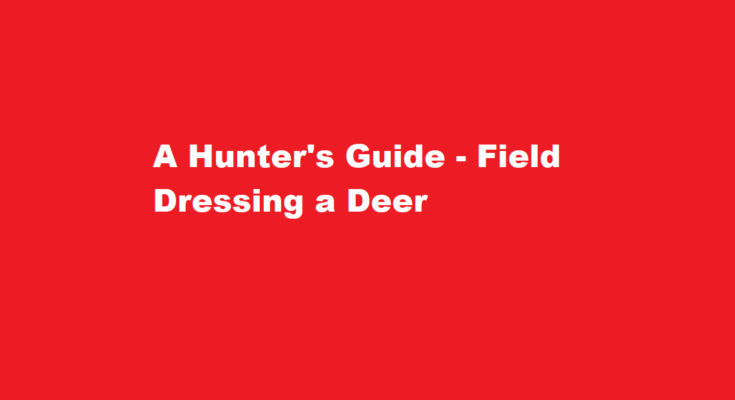Introduction
For many hunters, the culmination of hours of patience, skill, and dedication is the successful harvest of a deer. However, the work is far from over once you’ve pulled the trigger or released the arrow. Field dressing a deer is a crucial skill every hunter should master. Proper field dressing ensures the preservation of meat quality and minimises the risk of spoilage. In this article, we will provide a comprehensive guide on how to field dress a deer, step by step.
Materials Needed
Before getting into the process, make sure you have the necessary tools and materials at hand. You’ll need
1. Sharp hunting knife
2. Latex or nitrile gloves
3. Game bags or a clean tarp
4. Rope or paracord
5. Plastic bags or game bags for the meat
6. A cooler with ice packs or dry ice
7. A clean, flat surface to work on
Safety First
Before you start field dressing a deer, ensure you are wearing gloves to minimise contact with blood and potentially contaminated surfaces. Safety should always be a top priority while handling game, so remember to carry your firearm or bow unloaded and follow proper firearm safety rules.
Position the Deer
Lay the deer on its back with its legs facing upwards. Position it on a clean, flat surface, like a tarp, to prevent soil or debris from contaminating the meat.
Begin the Incision
Start by making a shallow incision from the base of the sternum (breastbone) to the pelvic bone. Use your knife to cut through the skin, taking care not to puncture the intestines or stomach. Be cautious when cutting through the abdominal wall to avoid piercing the internal organs.
Expose the Cavity
Using your hands and knife, gently separate the skin and muscle from the body cavity. This will expose the internal organs, allowing you to remove them without puncturing them.
Remove the Organs
Carefully cut around the anus, freeing it from the surrounding tissue. Tie it off with a piece of rope or paracord to prevent contamination. Proceed to remove the internal organs, including the intestines, stomach, and bladder, by gently pulling them out of the body cavity. Take care not to puncture any of these organs, as it can lead to meat spoilage.
Trim the Diaphragm
The diaphragm is a thin, muscular membrane that separates the chest cavity from the abdominal cavity. Locate it and cut it away from the rib cage. This step is important to ensure the thorough removal of all organs and to improve the overall quality of the meat.
Inspect and Rinse
With the internal organs removed, take a moment to inspect the cavity for any remaining debris or blood clots. Rinse the cavity with clean water to remove any remaining contaminants.
Cool the Meat
Properly cooling the meat is essential to preserve its quality. Place bags of ice or dry ice inside the body cavity to cool the meat quickly. This helps prevent spoilage and the growth of bacteria. Keep the cavity open to allow air circulation.
Secure the Deer
Once the deer is field dressed, you can hang it from a tree or place it in a game bag to transport it to your vehicle. Be sure to tag the deer according to your local regulations.
Transport and Store
When you’re ready to leave the field, transport the deer to a cool place as soon as possible. Ideally, store it in a cooler with ice packs or dry ice to keep the meat at a safe temperature. Proper storage is essential to maintain meat quality until it can be processed further.
FREQUENTLY ASKED QUESTIONS
Is it easy to field dress a deer?
The concept of field dressing a deer can be quite intimidating, especially if you’ve never done it before. Fortunately, it’s not all that difficult. The steps involved are fairly simple and mostly common sense and as I like to say, after the first 100 or so, it becomes second nature.
How soon should you field dress a deer?
Field Dressing, whether in the field or back at camp, should be done soon after harvesting the animal. It involves removing all the internal organs from the body cavity. This first step begins the cooling down of the meat. An experienced hunter should guide the novice in the procedure.
Conclusion
Field dressing a deer is a critical skill that every responsible hunter should master. By following the steps outlined in this guide, you can ensure the quality and safety of the meat you harvest while also adhering to ethical and responsible hunting practices. Remember to always check and comply with local hunting regulations and guidelines to ensure a successful and legal hunting experience. Happy hunting!
Read Also : Unmasking The Deceit – How to Identify a Fake Text Message



